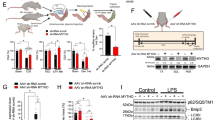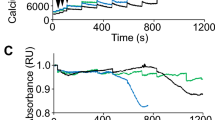Abstract
Autophagy is crucial in the turnover of cell components, and clearance of damaged organelles by the autophagic-lysosomal pathway is essential for tissue homeostasis. Defects of this degradative system have a role in various diseases, but little is known about autophagy in muscular dystrophies. We have previously found that muscular dystrophies linked to collagen VI deficiency show dysfunctional mitochondria and spontaneous apoptosis, leading to myofiber degeneration. Here we demonstrate that this persistence of abnormal organelles and apoptosis are caused by defective autophagy. Skeletal muscles of collagen VI–knockout (Col6a1−/−) mice had impaired autophagic flux, which matched the lower induction of beclin-1 and BCL-2/adenovirus E1B–interacting protein-3 (Bnip3) and the lack of autophagosomes after starvation. Forced activation of autophagy by genetic, dietary and pharmacological approaches restored myofiber survival and ameliorated the dystrophic phenotype of Col6a1−/− mice. Furthermore, muscle biopsies from subjects with Bethlem myopathy or Ullrich congenital muscular dystrophy had reduced protein amounts of beclin-1 and Bnip3. These findings indicate that defective activation of the autophagic machinery is pathogenic in some congenital muscular dystrophies.
This is a preview of subscription content, access via your institution
Access options
Subscription info for Japanese customers
We have a dedicated website for our Japanese customers. Please go to natureasia.com to subscribe to this journal.
Buy this article
- Purchase on SpringerLink
- Instant access to full article PDF
Prices may be subject to local taxes which are calculated during checkout






Similar content being viewed by others
Change history
02 March 2011
In the version of this article initially published, the affiliation of two of the authors was incorrectly listed. The Institute of Medical Genetics-National Research Council, Bologna, Italy should have been listed as the Institute of Molecular Genetics, National Research Council, c/o Rizzoli Orthopaedic Institute, Bologna, Italy. The error has been corrected in the HTML and PDF versions of the article.
References
Levine, B. & Kroemer, G. Autophagy in the pathogenesis of disease. Cell 132, 27–42 (2008).
Maiuri, M.C., Zalckvar, E., Kimchi, A. & Kroemer, G. Self-eating and self-killing: crosstalk between autophagy and apoptosis. Nat. Rev. Mol. Cell Biol. 8, 741–752 (2007).
Mizushima, N., Levine, B., Cuervo, A.M. & Klionsky, D.J. Autophagy fights disease through cellular self-digestion. Nature 451, 1069–1075 (2008).
Nakai, A. et al. The role of autophagy in cardiomyocytes in the basal state and in response to hemodynamic stress. Nat. Med. 13, 619–624 (2007).
Green, D.R. & Kroemer, G. The pathophysiology of mitochondrial cell death. Science 305, 626–629 (2004).
Bernardi, P. et al. The mitochondrial permeability transition from in vitro artifact to disease target. FEBS J. 273, 2077–2099 (2006).
Kim, I., Rodriguez-Enriquez, S. & Lemasters, J.J. Selective degradation of mitochondria by mitophagy. Arch. Biochem. Biophys. 462, 245–253 (2007).
Lampe, A.K. & Bushby, K.M. Collagen VI related muscle disorders. J. Med. Genet. 42, 673–685 (2005).
Irwin, W.A. et al. Mitochondrial dysfunction and apoptosis in myopathic mice with collagen VI deficiency. Nat. Genet. 35, 367–371 (2003).
Angelin, A. et al. Mitochondrial dysfunction in the pathogenesis of Ullrich congenital muscular dystrophy and prospective therapy with cyclosporins. Proc. Natl. Acad. Sci. USA 104, 991–996 (2007).
Long, Y.C. & Zierath, J.R. AMP-activated protein kinase signaling in metabolic regulation. J. Clin. Invest. 116, 1776–1783 (2006).
Mizushima, N., Yamamoto, A., Matsui, M., Yoshimori, T. & Ohsumi, Y. In vivo analysis of autophagy in response to nutrient starvation using transgenic mice expressing a fluorescent autophagosome marker. Mol. Biol. Cell 15, 1101–1111 (2004).
Mizushima, N., Yoshimori, T. & Levine, B. Methods in mammalian autophagy research. Cell 140, 313–326 (2010).
Klionsky, D.J. et al. Guidelines for the use and interpretation of assays for monitoring autophagy in higher eukaryotes. Autophagy 4, 151–175 (2008).
Mammucari, C. et al. FoxO3 controls autophagy in skeletal muscle in vivo. Cell Metab. 6, 458–471 (2007).
Schmalbruch, H. The early changes in experimental myopathy induced by chloroquine and chlorphentermine. J. Neuropathol. Exp. Neurol. 39, 65–81 (1980).
Rubinsztein, D.C., Gestwicki, J.E., Murphy, L.O. & Klionsky, D.J. Potential therapeutic applications of autophagy. Nat. Rev. Drug Discov. 6, 304–312 (2007).
Bjørkøy, G. et al. p62/SQSTM1 forms protein aggregates degraded by autophagy and has a protective effect on huntingtin-induced cell death. J. Cell Biol. 171, 603–614 (2005).
Hamacher-Brady, A. et al. Response to myocardial ischemia/reperfusion injury involves Bnip3 and autophagy. Cell Death Differ. 14, 146–157 (2007).
Sandoval, H. et al. Essential role for Nix in autophagic maturation of erythroid cells. Nature 454, 232–235 (2008).
Pattingre, S. et al. Bcl-2 antiapoptotic proteins inhibit beclin-1–dependent autophagy. Cell 122, 927–939 (2005).
Sandri, M. et al. FoxO transcription factors induce the atrophy-related ubiquitin ligase atrogin-1 and cause skeletal muscle atrophy. Cell 117, 399–412 (2004).
Shintani, T. & Klionsky, D.J. Autophagy in health and disease: a double-edged sword. Science 306, 990–995 (2004).
Romanello, V. et al. Mitochondrial fission and remodelling contributes to muscle atrophy. EMBO J. 29, 1774–1785 (2010).
Codogno, P. & Meijer, A.J. Autophagy and signaling: their role in cell survival and cell death. Cell Death Differ. 12 Suppl 2, 1509–1518 (2005).
Mizushima, N. Autophagy: process and function. Genes Dev. 21, 2861–2873 (2007).
Mortimore, G.E. & Poso, A.R. Intracellular protein catabolism and its control during nutrient deprivation and supply. Annu. Rev. Nutr. 7, 539–564 (1987).
Sugawara, T., Ito, Y., Nishizawa, N. & Nagasawa, T. Regulation of muscle protein degradation, not synthesis, by dietary leucine in rats fed a protein-deficient diet. Amino Acids 37, 609–616 (2009).
Yoo, Y.M. & Jeung, E.B. Melatonin suppresses cyclosporine A–induced autophagy in rat pituitary GH3 cells. J. Pineal Res. 48, 204–211 (2010).
Pallet, N. et al. Autophagy protects renal tubular cells against cyclosporine toxicity. Autophagy 4, 783–791 (2008).
Menazza, S. et al. Oxidative stress by monoamine oxidases is causally involved in myofiber damage in muscular dystrophy. Hum. Mol. Genet. published online, doi:10.1093/hmg/ddq339 (17 August 2010).
Boya, P. et al. Inhibition of macroautophagy triggers apoptosis. Mol. Cell. Biol. 25, 1025–1040 (2005).
Masiero, E. et al. Autophagy is required to maintain muscle mass. Cell Metab. 10, 507–515 (2009).
Wu, J.J. et al. Mitochondrial dysfunction and oxidative stress mediate the physiological impairment induced by the disruption of autophagy. Aging 1, 425–437 (2009).
Ramachandran, N. et al. VMA21 deficiency causes an autophagic myopathy by compromising V-ATPase activity and lysosomal acidification. Cell 137, 235–246 (2009).
Malicdan, M.C., Noguchi, S., Nonaka, I., Saftig, P. & Nishino, I. Lysosomal myopathies: an excessive build-up in autophagosomes is too much to handle. Neuromuscul. Disord. 18, 521–529 (2008).
Palma, E. et al. Genetic ablation of cyclophilin D rescues mitochondrial defects and prevents muscle apoptosis in collagen VI myopathic mice. Hum. Mol. Genet. 18, 2024–2031 (2009).
Merlini, L. et al. Cyclosporin A corrects mitochondrial dysfunction and muscle apoptosis in patients with collagen VI myopathies. Proc. Natl. Acad. Sci. USA 105, 5225–5229 (2008).
Tanida, I. et al. HsAtg4B/HsApg4B/autophagin-1 cleaves the carboxyl termini of three human Atg8 homologues and delipidates microtubule-associated protein light chain 3– and GABAA receptor-associated protein–phospholipid conjugates. J. Biol. Chem. 279, 36268–36276 (2004).
Zhong, Y. et al. Distinct regulation of autophagic activity by Atg14L and Rubicon associated with beclin-1–phosphatidylinositol-3-kinase complex. Nat. Cell Biol. 11, 468–476 (2009).
Degrassi, A. et al. Transfer of HIV-1 to human tonsillar stromal cells following cocultivation with infected lymphocytes. AIDS Res. Hum. Retroviruses 10, 675–682 (1994).
Blaauw, B. et al. Akt activation prevents the force drop induced by eccentric contractions in dystrophin-deficient skeletal muscle. Hum. Mol. Genet. 17, 3686–3696 (2008).
Pepe, G. et al. Bethlem myopathy (BETHLEM) and Ullrich scleroatonic muscular dystrophy: 100th ENMC international workshop, 23–24 November 2001, Naarden, The Netherlands. Neuromuscul. Disord. 12, 984–993 (2002).
Acknowledgements
We thank N. Bergamin for her involvement in the initial study, P. Braghetta for help with mouse manipulations, E. Rizzo and S. Castagnaro for histology, S. Cogliati for assistance with mitochondria isolation and F. Gualandi for muscle biopsies. We are grateful to N. Heintz (Rockefeller University) for supplying the beclin-1–EGFP expression construct and E. Kominami (Juntendo University School of Medicine) for the YFP-LC3 construct. This work was supported by the Telethon Foundation (GGP08107 and TCP04009), the Italian Ministry of University and Research, Association Francaise contre les Myopathies and the EU (BIO-NMD and MYOAGE).
Author information
Authors and Affiliations
Contributions
P.G. performed biochemical analyses, autophagy assays, mouse treatments, analysis and interpretation of data, and contributed to manuscript preparation. L.C. carried out RNA analysis, muscle transfections, molecular biology, analysis and interpretation of data, and contributed to manuscript preparation. P.S. performed electron microscopy. M.C. performed TUNEL and histology. A.A. performed tetramethylrhodamine methyl ester (TMRM) analysis. E.B. carried out muscle transfections and mitochondria isolation. B.B. analyzed muscle mechanics. A.U. performed TUNEL analysis. T.T. genotyped and maintained mice. L.M., P. Bernardi and N.M.M. were involved in data analysis. P. Bonaldo and M.S. designed the study, analyzed data and wrote the paper. All authors discussed the results and commented on the manuscript.
Corresponding authors
Ethics declarations
Competing interests
The authors declare no competing financial interests.
Supplementary information
Supplementary Text and Figures
Supplementary Figures 1–8 and Supplementary Tables 1–3 (PDF 5587 kb)
Rights and permissions
About this article
Cite this article
Grumati, P., Coletto, L., Sabatelli, P. et al. Autophagy is defective in collagen VI muscular dystrophies, and its reactivation rescues myofiber degeneration. Nat Med 16, 1313–1320 (2010). https://doi.org/10.1038/nm.2247
Received:
Accepted:
Published:
Issue Date:
DOI: https://doi.org/10.1038/nm.2247



